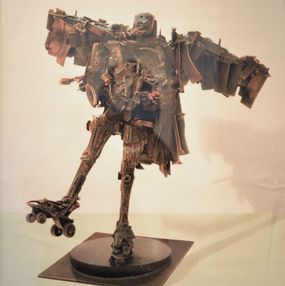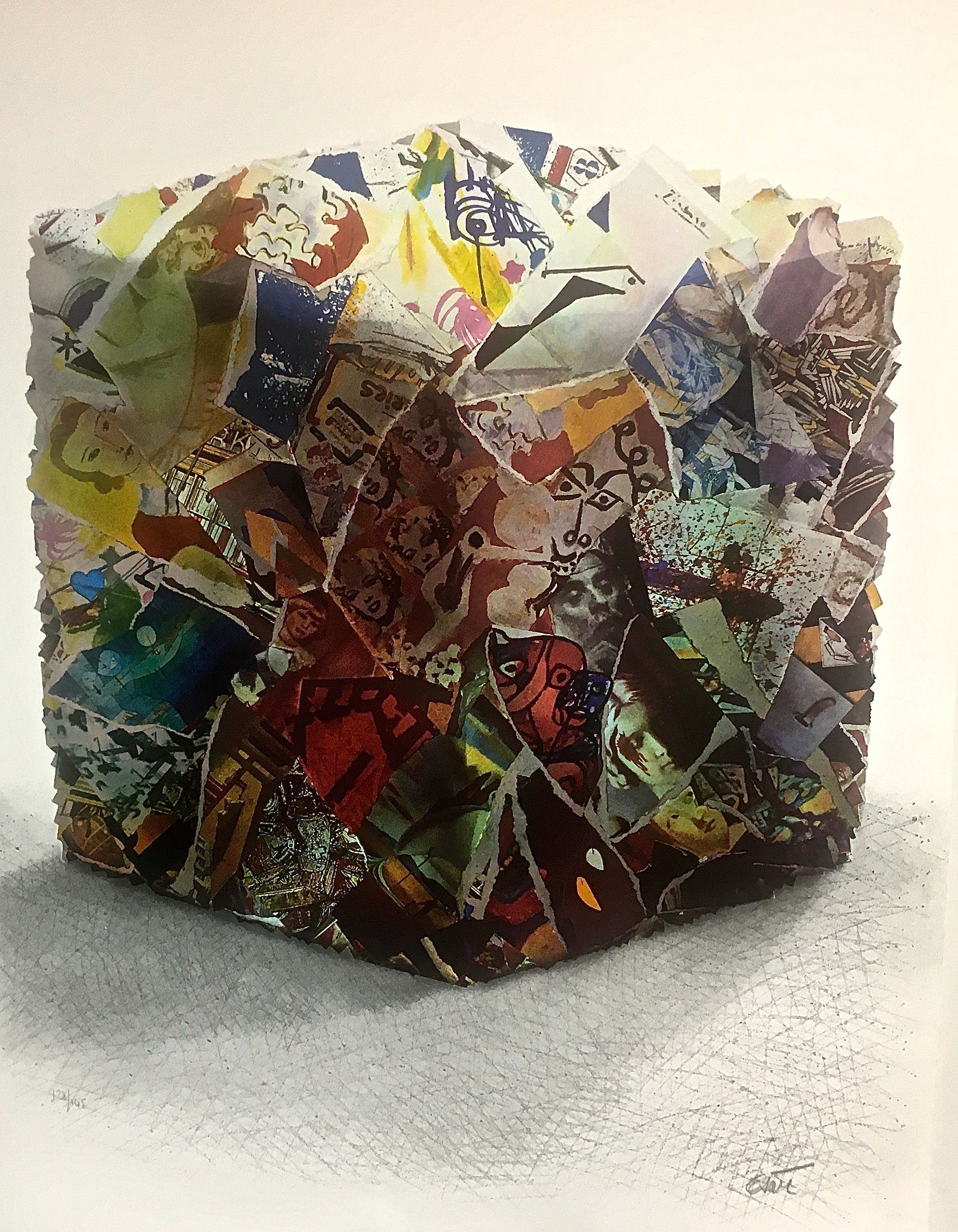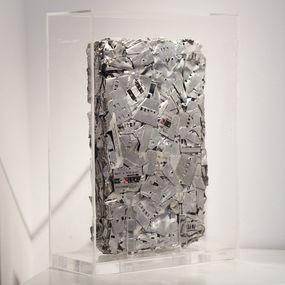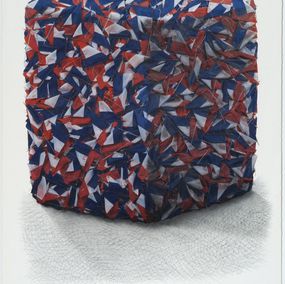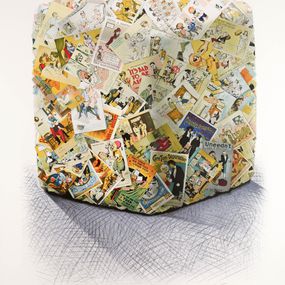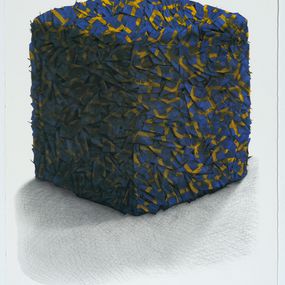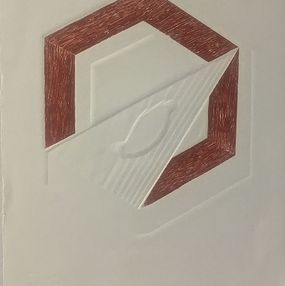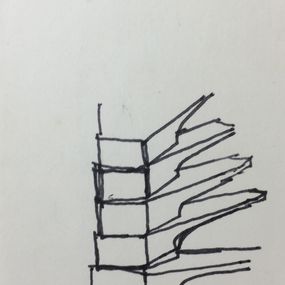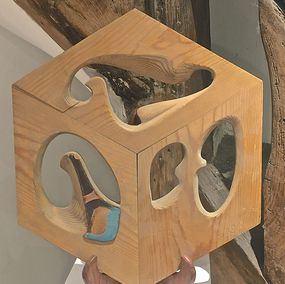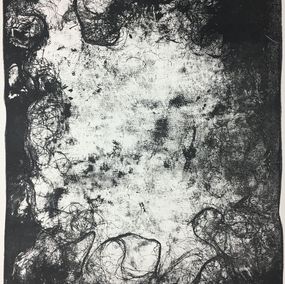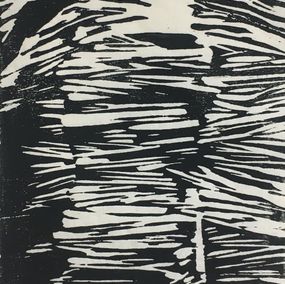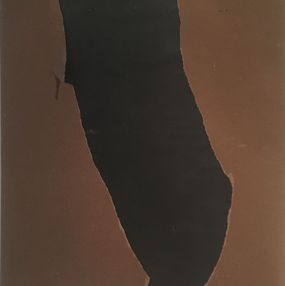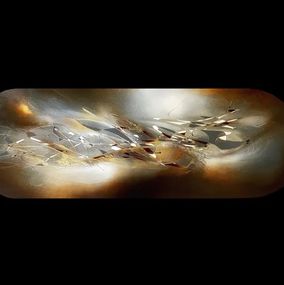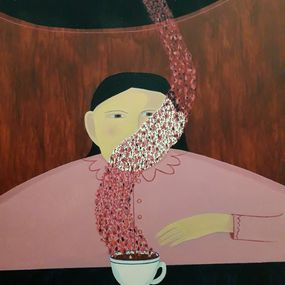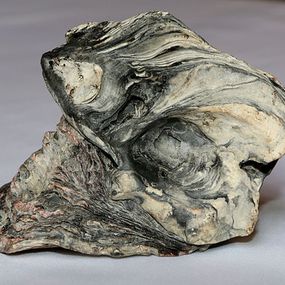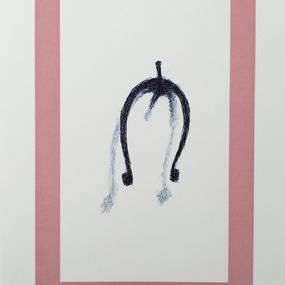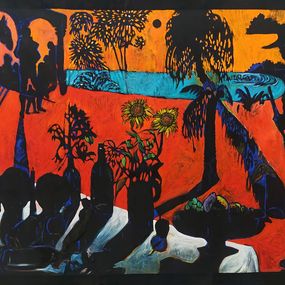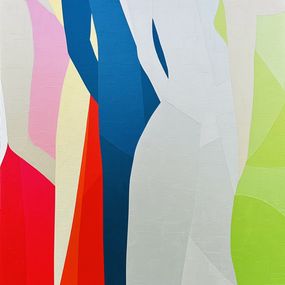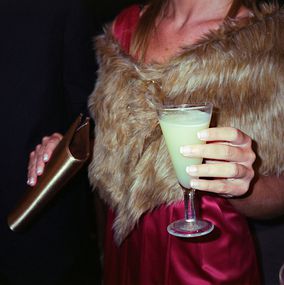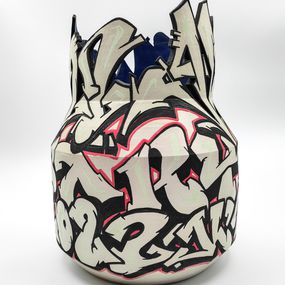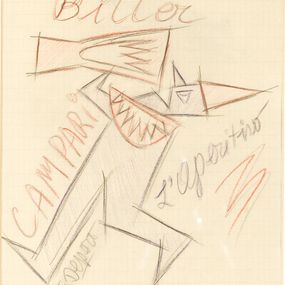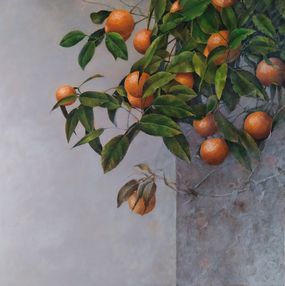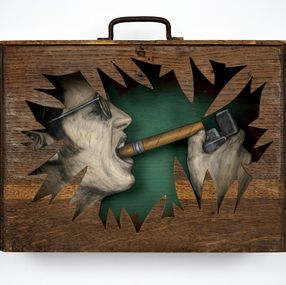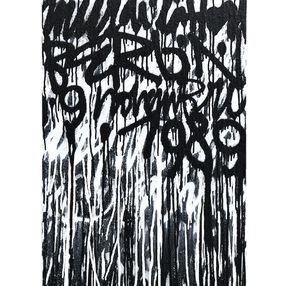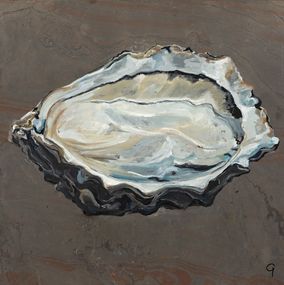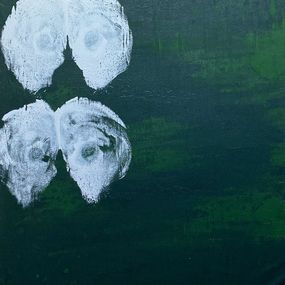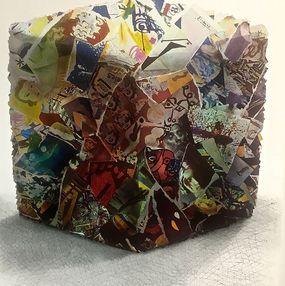CESAR FROM THE COMPRESSIONS FROM 1958 TO HIS DEATH IN 1998 Extract from "The Art of the Post-War School of Paris (1945-1999) Lise Cormery, Michelangelo Publications, 2021, Paris. Self-Starification "The Compressions Portrait of Caesar and Marilyn Monroe" In "The Compressions Portrait of Caesar and Marilyn Monroe" we find the starification of Caesar by himself, as well as various portraits of Marilyn Monroe. César liked to surround himself with “Stars” and to be “A Star among Stars”. He was always in search of the last event which allowed, as a Star guest to shine there under the spotlights. But, contrary to what we can read nowadays on the Internet, it was not easy for César to make himself known, however he did not hesitate to do everything possible to achieve notoriety. This is how Pierre Eelsen, Chairman and CEO of the airline Air Inter, in July 1984, explained to me, in complete confidentiality in 1996, on the occasion of the inauguration of the Joze CIUHA Museum in Slovenia, announced by a vernissage at the Galerie Lise Cormery, Paris, which César financed and offered his company thousands of greeting cards so that they could be distributed free of charge to the most influential personalities in order to make themselves known. Likewise, he dedicated some of his lithographs to his dearest friends so that his work would continue. Blessed are those who had the wisdom to collect his lithographs which he was willing to dedicate to his friends! A Biography of CESAR born César Baldaccini César Baldaccini, known as César, was born with his twin sister Amandine in 1921 in Marseilles and died in Paris in 1998. He is buried in the Cimetière du Montparnasse. His parents, Omer and Lelia Baldaccini, who came from Tuscany, ran a café in Marseille at 71, rue Loubon, in the Belle-de-Mai district. He left school in 1933, at the age of 12. From 1935 to 1939 he obtained the Prize for engraving, drawing and architecture at the Beaux-arts de Marseille. During the Second World War war of 1939-1945, César is not mobilized, in the same way the sculptor Albert Féraud enters the Beaux-arts of Paris in 1943 and Picasso sells to the Nazis the works of his artist friends who left to fight or die in the front or in a concentration camp. In 1945, César is back in Marseille, he gets married and opens a business. From 1947, he worked with plaster and iron and abandoned stone, because of its cost, but also, as he says, because he had a greater affinity with metal. César is a classically trained sculptor who masters the great drawing techniques. Massier at the Beaux-Arts in Paris, elected by the students, he manages the finances to buy the necessary equipment in the best conditions and pay for the models. Each class or workshop thus elects a Massier. Great post-war sculptors Paris is not yet an expensive city The great sculptors are Brancusi, who arrived on foot from his distant Romania, living without a penny, beadle in the Romanian church of rue Saint Jean de Beauvais in the 5th arrondissement of Paris, Giacometti, Richier… César has the chance to meet them all on a daily basis and to observe their technique and their unique style. Alberto Giacometti César lives in accommodation above Alberto Giacometti's studio, rue Hyppolyte Maindron, and visits it in the evening, soaking up and understanding the meaning of his “job”. Germaine Richier Like Giacometti, Germaine Richier has her studio door open and always works with a model while César, for lack of means, goes without, but it is she who will allow him to exhibit at the Salon de Mai, " Le Nu de Pompei", which although challenged by the Committee of the Salon de Mai, will be awarded by the critics (1954). Féraud and Brancusi It is Féraud who introduces César to Brancusi and this meeting will be felt as a visual shock, a lasting image, an illumination. 1949 “Le Nu Assis de Pompeii” In 1949, César obtains a grant which allows him to visit Pompeii in Italy, he discovers the famous casts of the victims of the volcanic eruption which inspires him “Le Nu assis de Pompeii”, which he wants to exhibit at the Salon de Mai, at the time a reference, but he would have been refused. César says that: “The secretary of the Salon de Mai sent me a letter summoning me to remove my work, because it was not acceptable. I was sad, because at the time, my colleagues were Picasso, Giacometti, Calder, and I was already old I still have doubts! Picasso said to me: "Do, do anything, but Do!" I am summoned, anxious, it was important for me to be next to Richier. The whole jury was there and declared that my sculpture is not in the spirit of the Salon de Mai! César in front of the Jury: I agree, since you don't like this sculpture, but the only sculptor who can tell me that is Germaine Richier! Germaine Richier: This kid is right! César: So, I'll leave it to you, where we left it, without placing it! It was "Le Nu de Pompei" In 1949, he was introduced to arc welding in an industrial carpentry in Trans-en-Provence and used lead in embossed sheets and welded iron wires. In 1951, he visited Pompeii again and was marked by the casts of the bodies of the inhabitants caught in the lava. In 1952, he used inexpensive salvage materials and made his first sculptures in welded scrap metal: his means were still modest. Thus, for lack of money and to afford marble, César will recover from scrap metal dumps the materials for his first sculptures: tubes, bolts, screws which become insects or find themselves in the powerful curves of “The Venus of Villetaneuse”, (1962). These are very beautiful sculptures. 1954 Galerie Lucien Durand Paris He exhibits at the Galerie Lucien Durand in Paris and obtains the "collaborator" prize for his iron sculpture "Le Poisson", made in Villetaneuse, a city where he will work for a dozen years thanks to the help of a local industrialist, Léon Jacques. He acquired fame when his work was bought for 100,000 francs in 1955 by the State for the National Museum of Modern Art, he exhibited at the Salon de Mai. 1955 the MNAM buys “Bat” from 1954 1955 The Museum of Modern Art of the City of Paris acquires “Le scorpion” 1955. From 1954 (Torse, MOMA Museum of Modern Art in New York, USA). In 1956, he took part in the Venice Biennale. 1957 César buys a studio, rue Campagne-Première in Paris. He married Rosine Groult-Baldaccini (met at the Beaux-Arts in 1948) with whom he had a daughter, Anna, a year later. He frequents the world of the night and assiduously seeks collectors by practicing Public Relations in social networks. In 1958, he signed a contract with the Claude Bernard gallery. In 1958, he flattened his first monumental compression, a Dauphine. 1959 Biennale de São Paulo and Documenta II in 1959. In 1976, he created the “César” cinema trophy, an award given by French film professionals, for which he made a bronze compression. Les Compressions César assembles deformed sheets in 1958 (Tiroir bleu). In 1958, he began by flattening a Dauphine. From the end of 1959, César focused his work on the "directed compression" technique, which became his trademark: using a hydraulic press, he compressed various objects in the form of parallelepipeds, first small format with copper tapes and sheets, then whole cars. 1960 At the Salon de Mai in 1960, he exhibited "Three Tons", a work made up of three compressed cars, which caused a scandal. 1969 The Mathias Fels gallery presents these transgressive works in 1969 so that they are recognized by the art world. 1961, Jean Lafont, friend of their common patron Marie-Laure de Noailles, offers him his first car (a brand new Soviet ZIM, the only one in circulation in France), which César sends back to him compressed, having lost 90% of its volume. 1986, he presents to the Cartier Foundation monumental compressions of Jean Todt's Peugeot 205 Turbo 16, damaged in car rallies, "Les Champions". At the Venice Biennale, he exhibited a mountain of compressions, a monumental work entitled “520 tons”. 1998, his “Milanese Suite” was produced with a series of new Fiat cars which, once compressed, passed through the paint rooms of the Fiat factory in Turin, in the colors of the range of the year. César also compresses all sorts of materials: fabrics, papers, and even gold jewelry that the women of the world bring him and which he returns compressed into cubes to wear around their necks. Expansions By reversing the spirit of compressions, César presented at the Salon de Mai in 1967 The large orange expansion, made of polyurethane From 1969, he perfected a method to ensure better conservation of his “Expansion”. These exploit the possibilities of this material in smooth and hard castings; the intervention of the creator is done either on the rigidity, the thickness, the coloring, or on the castings (superposition or juxtaposition) or on the fixed mass (finishing work in the form of topping, sanding, lacquering). Embedding objects in resin In the 1970s, he achieved international recognition. In 1971, he began to work with molten crystal or cast iron and coated objects in transparent plastic in 1971. Now universally known, he became one of the leading French artists and benefited from numerous exhibitions. His work "Conserve expansion - Martial Raysse, 1970-1972", is kept at the Museo Cantonale d'Arte in Lugano. Human Footprints: "The Thumb" The invitation to participate in a group exhibition devoted to "The Hand, from Rodin to Picasso" and his discovery of pantographic enlargement inspired him to create his "Thumb" sculptures. In 1965, he presented his famous Enlarged Thumb (1.85 meters high). It's his own thumbprint. On the occasion of the Olympic Games in South Korea, Seoul, in 1988, he created a bronze Thumb 6 meters high. This work has been the most publicized and reproduced. He created "The Fist", a monumental 7-tonne sculpture in polished stainless steel, installed on the Place d'Armes at the Saint-Cyr military school in the summer of 1970. Irons and imaginary animals "Fanny Fanny" (1990), Montreal Museum of Fine Arts. César began in 1949 to appropriate the technique of arc welding and created more than 300 constructions until 1966. 1983-1985 César sculpts and completes his "Centaure Tribute to Pablo Picasso", a 4.70 meter sculpture high, in 1985. The sculpture is installed at the crossroads of the Red Cross in Paris. This work will be refused for years by the City of Paris. Solo Shows Exhibitions 1952 In Provence he begins to make sculptures in inexpensive recycled materials such as scrap metal, for lack of means. 1954 Exhibition at Galerie Lucien Durand, Paris “Les Oiseaux”, “Les Insectes”, “Le Poisson” Museum of Modern Art in Paris, and scrap metal sculptures. 1956 Galerie Iris Clert, (Athens 1918 - 1986 Paris), the locomotive of the "New Realists", from February 1956, installed at 3 rue des Beaux-Arts in Paris, invents original media events for the launch of its artists in Paris or New York Pierre Restany, then improvised art critic and invoiced him his fees to classify on paper all the artists of his gallery under the name of "Nouveau Réalisme", mixing César with Arman, Yves Klein, Jean Tinguely, Niki de Saint Phalle, Martial Raysse, Daniel Spoerri, Raymond Hains and Jacques Villeglé. César, declares himself unique and will denounce this fabricated and abusive classification with humor during a radio interview, answering about his creations in the face of the New Realists movement: "I am... an appendage, I am... an excrescence. " The New Realists is Yves Klein. That's the New Realists. There is only one. I am New Realist because I am in the same street as Yves Klein." THE COMPRESSION ACCORDING TO CESAR "Even when I do the compression, there is always the sculptor behind" César 1959 What does compression mean? brought to contemporary art? César invents a new world of sculpture using scrap metal as an artistic material. He will say that what will provoke his conception of the "Compressions" is first of all, a lack of means without doubt, the sculptor being always driven by his need to sculpt constantly, but also an intellectual journey, César: "It's a very curious story. I had a small Fiat 500 and I often went to the scrap dealers in Aubervilliers. By dint of going to this factory, I always had the same scrap metal for my sculptures. In France, scrap dealers had presses to compress precious metals, copper, aluminum But, there was no press yet for large pieces." "It was expensive material, but it was like bricks, for me." "One day I took these pieces, and I I did "like Braque taking a pebble", or Picasso, because it's the same thing in the end, depending on the material you put under the press, you have a language that is created" "At the beginning, my "compressions" were precious metals, bronze, aluminum, copper, silver. Those of the "César du Cinéma" were old-fashioned bronze furniture decorations." There was no big press in France but when I watched the workers working on the presses, I was intrigued, The revelation for monumental "Compressions" sculptures From New York in 1959 The transition to monumental compressions came to him, says César, while watching the documentary film "Incredible America" from 1959, by the adventurer and director Marcel Isy-Schwart, who filmed including car waste in the Bronx: "What do I see? A mountain of cars, with huge presses! This is where I made the decision. ! " exclaims César! I ask Schwartz: Where is this press? They tell me in New York, in The Bronx, I telephone an artist friend, Arnal, who is in New York, I send him the reel of the film and tell him: send me a "Compression"! You take any one, it doesn't matter, the important thing is the block that you choose according to your retina, according to your taste." Cuts from César in Gennevilliers in 1960 "The breakage and its press offer me a palette!" César 1960 César discovers in a junkyard in Gennevilliers a hydraulic press, coming from the United States, which reduced a vehicle to the state of a parallelepiped of sheet metal. I go to the scrapyard and I see masons at work. Caesar: What are you doing? Masons: We are installing an American press. At that time, it's a real revelation, the breakage offers me a palette, I can choose the material that suits my work and give it shape by compression, ç I come back two days later, there are already had a mountain! The workers prepare everything for me and I then create two Compressions, Le moulon in a more improvised way. "I am a chance" The "Three tons", May 8, 1960 1960 On May 8, 1960, is inaugurated at the Museum of Modern Art of the City of Paris the Salon de Mai, the Committee of organizers refuses to place his work it this is how it remains unloaded "at the bottom of the truck", without any kind of artistic presentation. It is this same refusal that will earn him all the attention of the media. We are in an era of artistic provocation, not in a period of artistic transcendence. "Three Tons" is the name of the Three Car Cuts. His dealer at the time, Claude Bernard, considered the "Compressions" unsaleable. He prefers the sculptures, “Les Fers” which sell well, because they are more sculptural. César: "The beginning of welded iron, in the workshop of the Ecole des Beaux-Arts, we made frames with small butterflies to make earth on them. When it was dry, the wire was more beautiful iron than the earth. And yet I am for the Academy, Dali too! For the Firefighters, I always admire the know-how! Putting earth on reinforcements is difficult, I'm never there come If I had succeeded I would have stopped, that's why I continue..." "Les Compressions" 2 years before the American Minimalists César with his Compressions is ahead of the international art world, two years before the works American minimalists, a market that will soon become fashionable and considerable 1961 The famous Galerie Claude Bernard exhibits it in 1961, at the Saidenberg gallery of Eleanore Block (1911–1999) in New York, but it is a failure Despite his highly talented international dealer, César persevered in the path of "Compressions" and traced his path, with smaller objects, playing with materials and the use of the press. César's "Compression Portraits" , From the 1970s to his death César continued to dig the furrow of his "Compressions", he soon took a new path which he deepened over time, the "Compression Portraits". research and work of his work, with other essays on the s phenomena of crushing and deformation of the material or the image, but this time with no longer four dimensions in volume, but two dimensions, on a flat surface, the beautiful art paper, fine art of quality, which opens up infinite portrait perspectives, depending on his inspiration and his creation. Compression, then considered as a rupture, allows him to explore the side roads that seduce him. "All materials are sculptor's materials. There is no material that is not sculptor's material. You take paper, cloth... I don't believe there are limits in materials For the sculptor, it's a question of freedom, a question of sensitivity, it's a question of passion." César says: "The first contemporary sculptor I looked at was Rodin!" His master Rodin fragmented bodies in his sculptures, he called this "abattis", his fragmentation and his assembly of "pieces" of bodies, arms , heads, legs, hands. And César, like Rodin, fragments our contemporary world, with portraits of stars, pieces of objects, symbols, portraits of individuals, playing on optical illusion and color harmonies. It is also in this spirit that César refuses the term "happening" because "it's an English word", he prefers to speak of "ephemeral forms" as cooks do, because "sculptors are also cooks "they mix ingredients, sometimes surprising or improbable, to create a universe. "There is poor art, "L'Arte Povera" but after all, I made Poor Art but I didn't do it on purpose." "Compressions" from 1958 to 1998 César is an authentic sculptor. His work consisting of "Compressions" from 1958 to 1998 is the culmination of in-depth research, and a series of variations. If the Compressions have become like the brand image of the artist César, they are in fact the fruit of a long work of sculptor who chooses shapes and assembles them in order to stimulate or please his "retina " * César's "Compressions" correspond to a first sculptural and then pictorial declination of fragments that he chooses according to the subject or the graphic palette. Caesar's expressions "All materials are sculptor's materials. There is no material that is not a sculptor's material You take paper, cloth... I don't think there are limits in the materials. For the sculptor, it's a question of freedom, a question of sensitivity, it's a question of passion." César He gives his opinion on the ephemeral side of his works but refuses the term "happening" because "it is an English word", he prefers to speak of "ephemeral forms" like cooks, because "Sculptors are also cooks" says César, they too mix ingredients, they try experiments for the taste of the eye , that's what a sculptor like César strives for. I am, as my mother used to say, MichelAngelo, Rodin, I am at the same time Duchamp, I am also Man Ray... I lived all that, I I mixed it all up. I found myself at Belle de Mai, (place of his childhood) at Cours Julien, Cours Julien, rue Bonaparte. [...] I was born twice: I was born the first time at the Belle de Mai and the second time rue Bonaparte. César will compress copper, sheet metal, metal, plastic, paper, cardboard, humble consumer objects or out of use, to which it gives a new appearance and unique and original value. An almost invariable, condensed, parallelepiped geometric form whose scale only varies, his “Compressions” are soon to be iconic totems, with a style recognizable among all the works. César, in the spirit of his very "Public Relations" side, wishes to embody himself there to the point that he takes up his name to baptize the prestigious ceremony of French cinema which chooses to reward its laureates with a model of " Compression” now the Césars of Cinema Trophy. As mentioned above César confides, it is first of all about pieces of compressed bronze furniture thrown in the dump by the craftsmen or second-hand dealers that he recovers. Compressions and their variations César will decline his "compressions" in multiple variations, artist's jewel compressions and miniature sculpture, made with metals and precious stones, only with humble objects that he has fun to compact. »Lise Cormery
Read more
